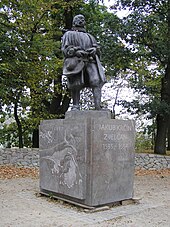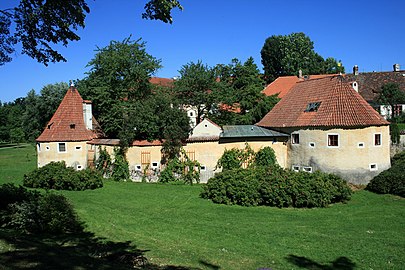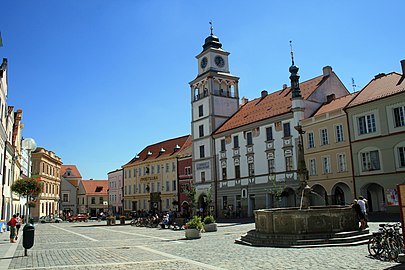Třeboň
| Třeboň | ||||
|---|---|---|---|---|
|
||||
| Basic data | ||||
| State : |
|
|||
| Historical part of the country : | Bohemia | |||
| Region : | Jihočeský kraj | |||
| District : | Jindřichův Hradec | |||
| Area : | 9833 ha | |||
| Geographic location : | 49 ° 0 ′ N , 14 ° 46 ′ E | |||
| Height: | 434 m nm | |||
| Residents : | 8,253 (Jan 1, 2019) | |||
| Postal code : | 379 01 | |||
| License plate : | C. | |||
| traffic | ||||
| Street: | Budweis - Jindřichův Hradec | |||
| Railway connection: | České Velenice – Veselí nad Lužnicí | |||
| structure | ||||
| Status: | city | |||
| Districts: | 8th | |||
| administration | ||||
| Mayor : | Jan Váňa (as of 2018) | |||
| Address: | Palackého nám. 46 / II 379 01 Třeboň |
|||
| Municipality number: | 547336 | |||
| Website : | www.mesto-trebon.cz | |||
Třeboň (German: Wittingau ) is a town with about 8,600 inhabitants in the Czech Republic . It belongs to the Jindřichův Hradec District in the South Bohemian Region . For a long time the town was owned by the noble families of Rosenberg and Schwarzenberg from South Bohemia , who also resided in Třeboň Castle. It is also known through the former monastery of the Augustinian Canons . One of the most important historical archives in the Czech Republic, founded in 1602, is still located in the city.
geography
The city in the Wittingau basin lies in a pond landscape with streams and canals to the west of the Lainsitz .
Community structure
The town of Třeboň consists of the districts of Branná ( Brannen ), Břilice ( Bschilitz ), Holičky ( Holitschka ), Nová Hlína ( Neulahm ), Přeseka ( Pscheseka ), Stará Hlína ( Altlahm ), Třeboň I and Třeboň II. Basic settlement units are Bianná , Břilice, Dvorce, Gigant, Holičky, Hvízdalka, K Břilicům, Komenského sady, Lázeňský areál, Mokrá luka-nad tratí, Mokrá luka-pod tutti, Na Kopečku, Nová Hlína, Obohr, Pářlána, Nové, Páříka Svět, Třeboň-střed, Třeboň-západ, U nádraží, Za Lužnicí and Zámecké polesí.
The municipality is divided into the cadastral districts of Branná, Břilice, Holičky u Staré Hlíny, Přeseka, Stará Hlína and Třeboň.
Neighboring communities
| Lomnice nad Lužnicí | Lužnice | Novosedly nad Nežárkou |
| Lišov , Dunajovice , Štěpánovice u Českých Budějovic |

|
Stříbřec , Chlum u Třeboně |
| Libín , Domanín | Hrachoviště , Cep | Majdalena |
history
The place was founded as a street village by the Witigones at the end of the 12th century . In 1185 part of the property came to the Cistercian monastery Zwettl , but was bought back around 1250 by the Landstein line of the Witigonen. The German place name Witingenowe is documented for the first time in 1261 , the Czech for 1267. The Aegidius Church is documented for the year 1280. In 1341 Wittingau was owned by Wilhelm von Landstein . For this year it is called a city.
In 1366 the Lords of Rosenberg acquired Wittingau. They founded in 1367 for the Augustinian canons the pin Trebon , which also includes the Giles Church has been assigned. In 1374 Wittingau had a town fortification, in 1384 the owners founded a hospital. In 1395 nobles under the leadership of the Rosenbergs formed an opposition to King Wenceslaus IV in Wittingau . During the Hussite Wars , the town was besieged by the Taborites in 1424 and 1425, without success . In the second half of the 15th century, the fortress was expanded into a castle under Wok von Rosenberg .
A cultural and economic boom followed in the 16th century under Wilhelm von Rosenberg . He developed a technically perfect pond economy, expanded the castle into a renaissance castle , and the town received a modern system of fortifications. The Renaissance houses on the market square were built in 1562 and the town hall in 1566. With the craft also developed guild system .
After Wilhelm's death in 1592 his brother Peter Wok von Rosenberg took over the town and rule of Wittingau. After selling Český Krumlov , he resided in Wittingau from 1602. He had the castle expanded and moved the Rosenberg family archive there. As a supporter of Lutheranism and later of the Bohemian Brothers , he met several times at his castle with leading Protestant, anti-Habsburg estate politicians from the Bohemian countries and the empire . With his death in 1611, the Rosenbergs died out.
In inheritance, the rule of Wittingau went to the Lords of Schwanberg . After the defeat in the Battle of the White Mountain , Wittingau became the center of the rebels, which withstood the attacks of the Imperial troops until March 1622. Thereafter, the goods of Peter von Schwanberg's widow, Anna Maximiliane von Oppersdorff, were confiscated and fell to Emperor Ferdinand II . On January 2, 1647, he gave the rule of Wittingau to his son, Archduke Leopold Wilhelm , who sold Wittingau on January 2, 1660 to Johann Adolf I. Graf von Schwarzenberg . However, the city and its rule only slowly recovered from the consequences of the Thirty Years' War . In 1723 and 1781 the city was destroyed by fires, each of which was followed by reconstruction. In the middle of the 18th century, pond farming grew again in importance. The monastery, which was finally secularized in 1785, and its possessions were acquired by the Prince of Schwarzenberg in 1787.
In the pre-March period , the Czech developed in Wittingau Patriot movement , which provided the majority of the community self-government since the 1848th František Palacký , who since 1824 frequently visited the Schwarzenberg family archive , played a major role in this development . After the end of patrimonial Wittingau became the district capital in 1855. The influence of the Schwarzenbergs on the city remained dominant, as they made great contributions to the economic development of the city and the associated prosperity of the population through the systematically improved pond management and the associated jobs. After 1870 they expanded the brewery.
With the land reform of 1924, the Schwarzenberg property was considerably reduced. After the Second World War , their property was nationalized in 1945. In 1956, the family and estate archives were also assigned to the Třeboň State Archives located in the chateau. Together with the Rosenberg archive, it is now the largest aristocratic archive in the country.
In 1960 the Třeboň District was dissolved. Because of the famous mud baths, the city received the status of a medicinal bath in the same year. The city hosts the International Animated Film Festival every year.
Pond and fish management
Třeboň has been a center of carp farming in South Bohemia since the 16th century . It goes back to the economic and cultural heyday of the last two Rosenbergs, the brothers Wilhelm and Peter Wok. Under the Rosenberg chief fish master Štěpánek Netolický , a canal system was created with the construction of the Goldbach in 1506–1520 , which connects all the large fish ponds in the Wittingau basin and with which the ponds already laid out in the 14th century were secured. Under the economic manager Jakob Krčín from Jelčany , the canal system with the construction of the Svět pond , whose name is derived from Zwettl , was technically perfect. Two suburbs of Wittingau were left for the pond. In 1584–1589, the Rosenberg pond north of the city was created, which is the largest pond in Bohemia with an area of 267 hectares.
Because of the ponds, Charles University in Prague runs a botany institute in Třeboň , which deals with the scientific study of algae and aquatic plants.
Culture and sights
Theaters and museums
- JKTyla City Theater, Masarykovo námesti 107
- Světozor cinema, Masarykovo námesti 1
- Akvárium Vratislavský dům, Krčínova 114
Buildings
The historic city center was declared an urban monument reserve in 1976 .
- The entrance to the Třeboň Castle is on the southwest corner of the main square.
- The Egidius Church dates from the 12th century. In 1367 it was transferred to the newly founded Augustinian Canons Monastery of Třeboň and then rebuilt as a two-aisled hall church. It became famous for its Gothic furnishings and the main altar with Gothic panel painting, which was created by the " Master of Wittingau " at the end of the 14th century . The current main altar is from 1781. Parts of the original altar have been preserved. You are in the Prague National Gallery. The Gothic limestone sculpture of the "Madonna von Wittingau" dates from around 1390.
- The town houses on the market square are part of the listed historic city center . They were built after 1562. In the middle of the square there is a fountain from 1569 and a Marian column from 1780.
- The town hall with tower was built in 1566. It was rebuilt at the beginning of the 19th century.
- The fortification wall was built in 1525–1527.
- The neo-Gothic mausoleum of the Schwarzenberg family was built between 1874 and 1877.
- Synagogue built in the 19th century
- Jewish Cemetery
- Three stumbling blocks for members of the Metzl family, victims of the Holocaust
Twin cities
-
 Horsens , Denmark
Horsens , Denmark -
 Interlaken , Switzerland
Interlaken , Switzerland -
 Schrems , Austria
Schrems , Austria -
 Utena , Lithuania
Utena , Lithuania
literature
- Joachim Bahlcke , Winfried Eberhard, Miloslav Polívka (eds.): Handbook of historical places . Volume: Bohemia and Moravia (= Kröner's pocket edition . Volume 329). Kröner, Stuttgart 1998, ISBN 3-520-32901-8 , pp. 666-668.
- Josef Šusta: Five centuries of pond management in Wittingau . Herrcke & Lebeling, Stettin 1899.
Web links
- City website
- List of listed objects in the monument catalog pamatkovykatalog.cz (Czech).
- International Festival for Animated Films (Czech / English)
Individual evidence
- ↑ http://www.uir.cz/obec/547336/Trebon
- ↑ Český statistický úřad - The population of the Czech municipalities as of January 1, 2019 (PDF; 0.8 MiB)
- ↑ http://www.uir.cz/casti-obce-obec/547336/Obec-Trebon
- ↑ http://www.uir.cz/zsj-obec/547336/Obec-Trebon
- ↑ http://www.uir.cz/katastralni-uzemi-obec/547336/Obec-Trebon
- ↑ Joachim Bahlcke, Winfried Eberhard, Miloslav Polívka (eds.): Handbook of historical sites. Volume: Bohemia and Moravia (= Kröner's pocket edition. Volume 329). Kröner, Stuttgart 1998, ISBN 3-520-32901-8 , p. 666.







